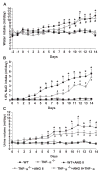Involvement of tumor necrosis factor-alpha in angiotensin II-mediated effects on salt appetite, hypertension, and cardiac hypertrophy
- PMID: 18391105
- PMCID: PMC2736909
- DOI: 10.1161/HYPERTENSIONAHA.107.102152
Involvement of tumor necrosis factor-alpha in angiotensin II-mediated effects on salt appetite, hypertension, and cardiac hypertrophy
Abstract
Hypertension is considered a low-grade inflammatory condition induced by various proinflammatory cytokines, including tumor necrosis factor (TNF)-alpha. Recent studies have implicated an involvement of TNF-alpha in the development of salt-sensitive hypertension induced by angiotensin II (Ang II). To understand further the relationship between TNF-alpha and Ang II, we examined the responses to Ang II in TNF-alpha knockout (TNF-alpha(-/-)) mice in the present study. A continuous infusion of Ang II (1 microg/kg per minute) for 2 weeks was given to both TNF-alpha(-/-) and wild-type (WT) mice with implanted osmotic minipumps. Daily measurement of water intake, salt intake, and urine output were performed using metabolic cages. Blood pressure was monitored continuously with implanted radiotelemetry. Ang II administration for 2 weeks caused increases in salt (0.2+/-0.07 to 5.6+/-0.95 mL/d) and water (5.4+/-0.34 to 11.5+/-1.2 mL/d) intake and in mean arterial pressure (115+/-1 to 151+/-3 mm Hg) in wild-type mice, but these responses were absent in TNF-alpha(-/-) mice (0.2+/-0.04 to 0.3+/-0.09 mL/d, 5.5+/-0.2 to 6.1+/-0.07 mL/d, and 113+/-2 to 123+/-3 mm Hg, respectively). Cardiac hypertrophy induced by Ang II was significantly attenuated in TNF-alpha(-/-) mice compared with wild-type mice. In a group of TNF-alpha(-/-) mice, when replacement therapy was made with recombinant TNF-alpha, Ang II induced similar responses in salt appetite, mean arterial pressure, and cardiac hypertrophy, as observed in wild-type mice. These results suggest that TNF-alpha plays a mechanistic role in mediating chronic Ang II-induced effects on salt appetite and blood pressure, as well as on cardiac hypertrophy.
Figures





Similar articles
-
Tumor Necrosis Factor - Alpha Is Essential for Angiotensin II-Induced Ventricular Remodeling: Role for Oxidative Stress.PLoS One. 2015 Sep 17;10(9):e0138372. doi: 10.1371/journal.pone.0138372. eCollection 2015. PLoS One. 2015. PMID: 26378790 Free PMC article.
-
TNF-α type 2 receptor mediates renal inflammatory response to chronic angiotensin II administration with high salt intake in mice.Am J Physiol Renal Physiol. 2013 Apr 1;304(7):F991-9. doi: 10.1152/ajprenal.00525.2012. Epub 2013 Feb 6. Am J Physiol Renal Physiol. 2013. PMID: 23389459 Free PMC article.
-
Angiotensin II-induced hypertension and cardiac hypertrophy are differentially mediated by TLR3- and TLR4-dependent pathways.Am J Physiol Heart Circ Physiol. 2019 May 1;316(5):H1027-H1038. doi: 10.1152/ajpheart.00697.2018. Epub 2019 Feb 22. Am J Physiol Heart Circ Physiol. 2019. PMID: 30793936 Free PMC article.
-
Angiotensin, thirst, and sodium appetite.Physiol Rev. 1998 Jul;78(3):583-686. doi: 10.1152/physrev.1998.78.3.583. Physiol Rev. 1998. PMID: 9674690 Review.
-
Tumor necrosis factor-α, kidney function, and hypertension.Am J Physiol Renal Physiol. 2017 Oct 1;313(4):F1005-F1008. doi: 10.1152/ajprenal.00535.2016. Epub 2017 Jul 19. Am J Physiol Renal Physiol. 2017. PMID: 28724611 Free PMC article. Review.
Cited by
-
Angiotensin II-Induced Signal Transduction Mechanisms for Cardiac Hypertrophy.Cells. 2022 Oct 22;11(21):3336. doi: 10.3390/cells11213336. Cells. 2022. PMID: 36359731 Free PMC article. Review.
-
Tumor necrosis factor α decreases nitric oxide synthase type 3 expression primarily via Rho/Rho kinase in the thick ascending limb.Hypertension. 2012 Jun;59(6):1145-50. doi: 10.1161/HYPERTENSIONAHA.111.189761. Epub 2012 May 7. Hypertension. 2012. PMID: 22566503 Free PMC article.
-
Lymphocyte responses exacerbate angiotensin II-dependent hypertension.Am J Physiol Regul Integr Comp Physiol. 2010 Apr;298(4):R1089-97. doi: 10.1152/ajpregu.00373.2009. Epub 2010 Feb 10. Am J Physiol Regul Integr Comp Physiol. 2010. PMID: 20147609 Free PMC article.
-
Adaptive Immunity in Hypertension.Curr Hypertens Rep. 2019 Jul 18;21(9):68. doi: 10.1007/s11906-019-0971-6. Curr Hypertens Rep. 2019. PMID: 31321561 Free PMC article. Review.
-
Impact of Immune System Activation and Vascular Impairment on Male and Female Sexual Dysfunction.Sex Med Rev. 2019 Oct;7(4):604-613. doi: 10.1016/j.sxmr.2019.05.005. Epub 2019 Jul 17. Sex Med Rev. 2019. PMID: 31326360 Free PMC article. Review.
References
-
- Brunner HR. Experimental and clinical evidence that angiotensin II is an independent risk factor for cardiovascular disease. Am J Cardiol. 2001;87:3C–9C. - PubMed
-
- Ruiz-Ortega M, Lorenzo O, Ruperez M, Esteban V, Suzuki Y, Mezzano S, Plaza JJ, Egido J. Role of the renin-angiotensin system in vascular diseases: expanding the field. Hypertension. 2001;38:1382–1387. - PubMed
-
- Kim S, Iwao H. Molecular and cellular mechanisms of angiotensin II-mediated cardiovascular and renal diseases. Pharmacol Rev. 2000;52:11–34. - PubMed
-
- Allen AM, Zhuo J, Mendelsohn FA. Localization and function of angio-tensin AT1 receptors. Am J Hypertens. 2000;13:31S–38S. - PubMed
-
- Murphy TJ, Alexander RW, Griendling KK, Runge MS, Bernstein KE. Isolation of a cDNA encoding the vascular type-1 angiotensin II receptor. Nature. 1991;351:233–236. - PubMed
Publication types
MeSH terms
Substances
Grants and funding
LinkOut - more resources
Full Text Sources
Other Literature Sources
Medical
Molecular Biology Databases
Miscellaneous

